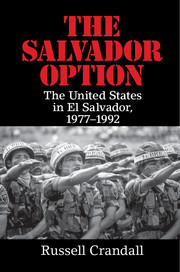Book contents
- Frontmatter
- Dedication
- Epigraph
- Contents
- List of Figures
- List of Organizations
- Acknowledgments
- 1 Introduction
- PART ONE EL SALVADOR IN THE COLD WAR
- PART TWO JIMMY CARTER
- PART THREE RONALD REAGAN
- 19 Reagan Arrives
- 20 Reagan and Salvador
- 21 El Mozote
- 22 Another Vietnam
- 23 Solidarity
- 24 Troop Cap and Certifying Human Rights
- 25 Reagan Gambles on Elections, 1982
- 26 The Shultz Doctrine
- 27 Human Rights
- 28 Henry Kissinger
- 29 Contras
- 30 “Elections Yes, Dialogue No,” 1984 Presidential Election
- 31 La Palma
- 32 Esquipulas
- 33 Counterinsurgency I
- 34 Counterinsurgency II
- 35 Zona Rosa
- 36 Air War
- 37 José Napoleón Duarte
- 38 Iran-Contra
- PART FOUR GEORGE H. W. BUSH
- PART FIVE POSTWAR
- Notes
- Bibliography
- Index
33 - Counterinsurgency I
from PART THREE - RONALD REAGAN
Published online by Cambridge University Press: 05 June 2016
- Frontmatter
- Dedication
- Epigraph
- Contents
- List of Figures
- List of Organizations
- Acknowledgments
- 1 Introduction
- PART ONE EL SALVADOR IN THE COLD WAR
- PART TWO JIMMY CARTER
- PART THREE RONALD REAGAN
- 19 Reagan Arrives
- 20 Reagan and Salvador
- 21 El Mozote
- 22 Another Vietnam
- 23 Solidarity
- 24 Troop Cap and Certifying Human Rights
- 25 Reagan Gambles on Elections, 1982
- 26 The Shultz Doctrine
- 27 Human Rights
- 28 Henry Kissinger
- 29 Contras
- 30 “Elections Yes, Dialogue No,” 1984 Presidential Election
- 31 La Palma
- 32 Esquipulas
- 33 Counterinsurgency I
- 34 Counterinsurgency II
- 35 Zona Rosa
- 36 Air War
- 37 José Napoleón Duarte
- 38 Iran-Contra
- PART FOUR GEORGE H. W. BUSH
- PART FIVE POSTWAR
- Notes
- Bibliography
- Index
Summary
If you spend your time chasing guerrillas, you do it forever and never get to the root cause of the insurgency.
– U.S. military review of the war in El SalvadorThe Reagan administration complains about the death squads in El Salvador. But its policy is for military victory, with negotiations only as window-dressing, and that doesn't give any chance to human rights. It just encourages the far right. And the policy isn't working. The “military progress” is fading away. So there will be more escalation, more American involvement.
– Guillermo Ungo, FDR leader, October 1983Their [Salvadoran military] idea of counterinsurgency I suppose was to round up the peasants and shoot them – never identifying who the insurgents were.
– Reagan administration officialWhat do El Salvador and Costa Rica have in common? Neither has an army.
– Langhorne “Tony” Motley, Assistant Secretary of State for Inter-American Affairs, 1983Tubeless Artillery and Planeless Bombs
With its sophisticated tactical and strategic doctrine and prodigious armaments acquired largely from sympathetic Marxist governments – largely via Cuba and Nicaragua – the FMLN was quickly becoming the largest and strongest insurgency in Latin American history. A few years into the war, the guerrillas were now benefiting from finally being able to overcome their factional rivalries to launch coordinated strikes and share intelligence and resources. This allowed the rebels to launch operations that at times involved thousands of soldiers, a stunning level of strength and sophistication for a guerrilla movement in Latin America.
In 1982, the FAES captured a large cache of documents from an FMLN safe house in San Salvador. The secret documents revealed that Cayetano Carpio's FPL faction had identified the use of elite commando units as a key element of the insurgent strategy. The guerrillas believed that these crack troops would serve as the “tubeless artillery” and “planeless bombs” needed to carry out the stunning raids that would humiliate the Salvadoran military and remind the country of the guerrillas’ invincibility. FMLN soldiers had in fact started receiving training in Cuba as early as 1980. By 1983 these units were ready to go into action to strike at the heart of the FAES.
- Type
- Chapter
- Information
- The Salvador OptionThe United States in El Salvador, 1977–1992, pp. 346 - 361Publisher: Cambridge University PressPrint publication year: 2016



